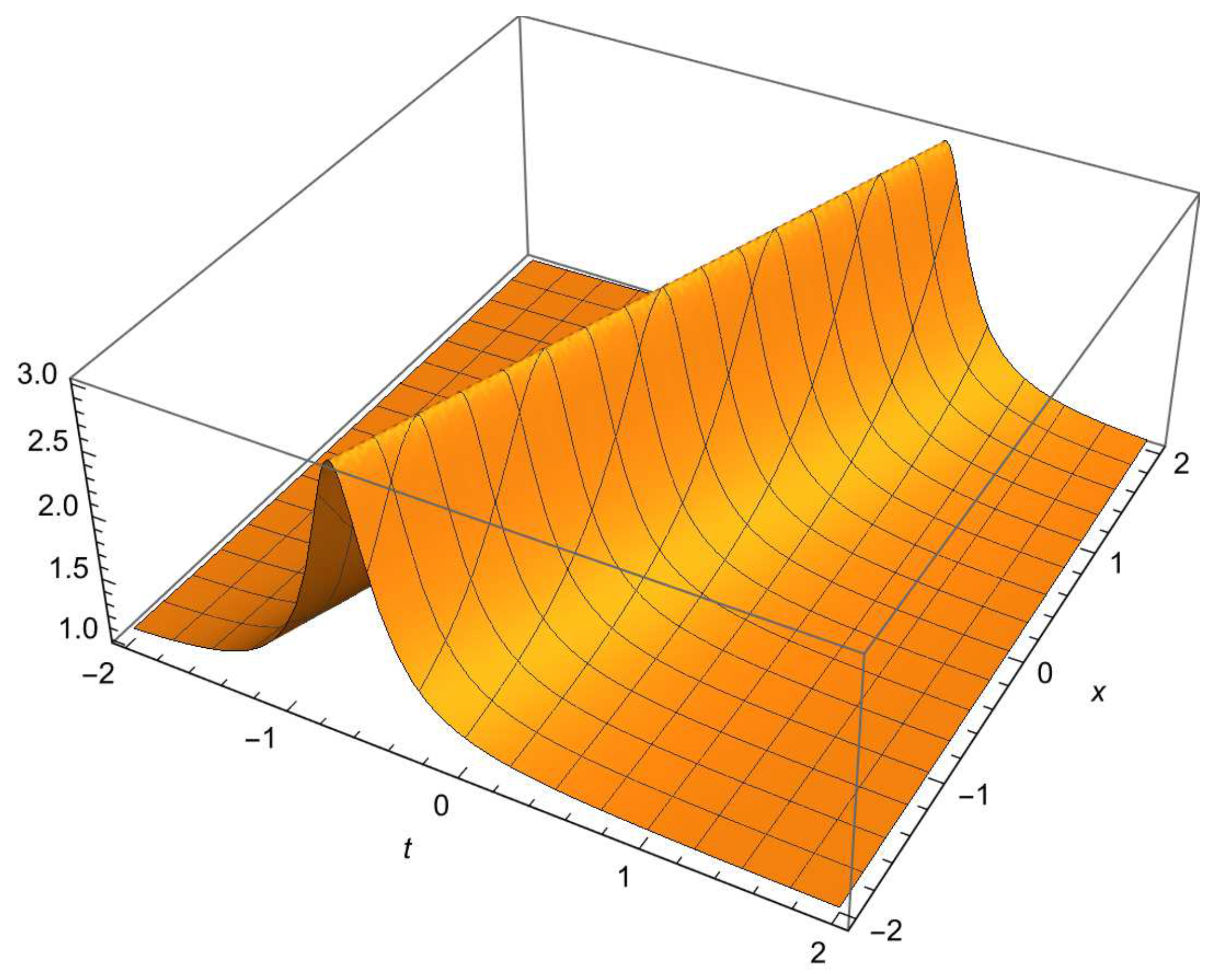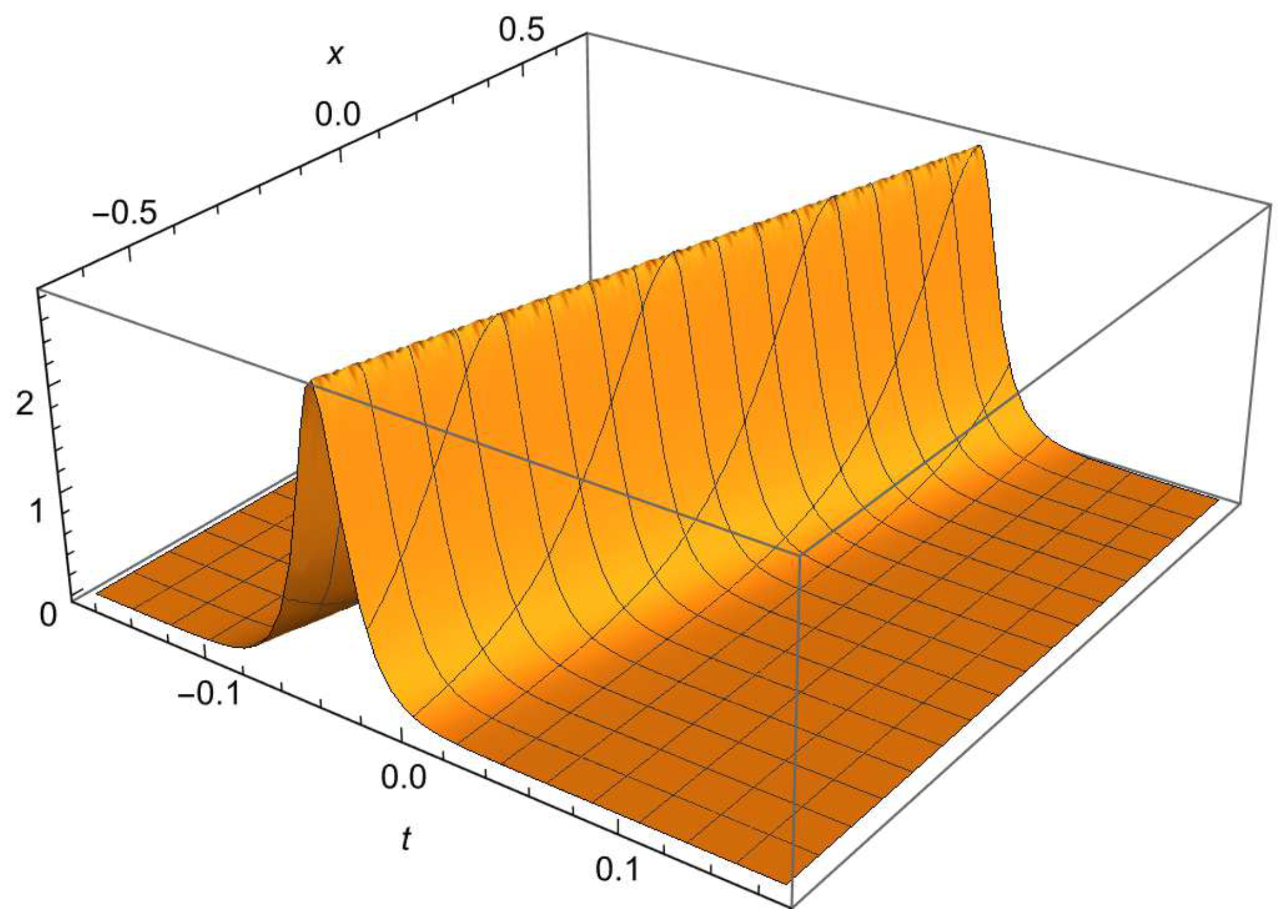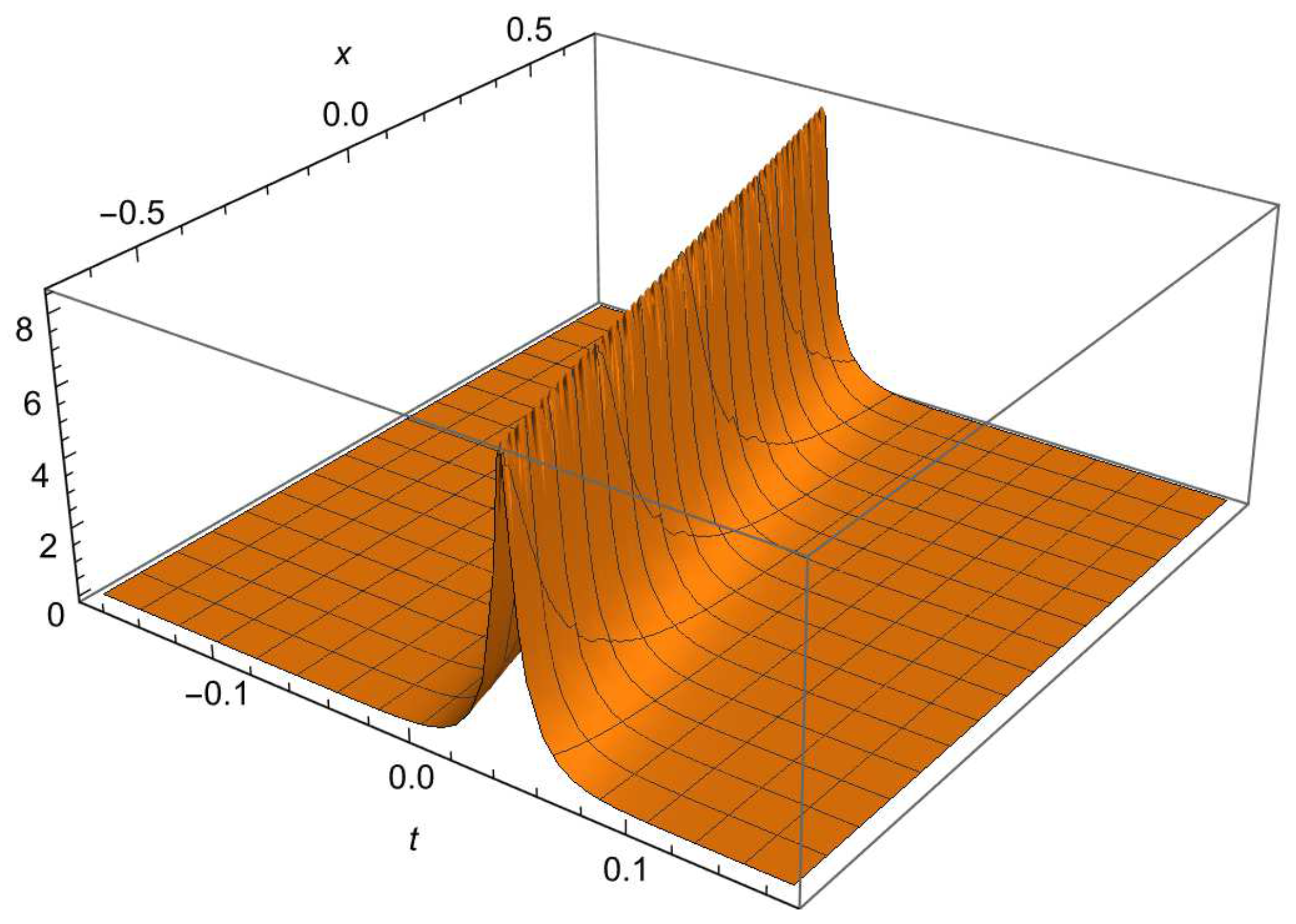Spectral Curves for the Derivative Nonlinear Schrödinger Equations
Abstract
:1. Introduction
2. Generalized DNLS Equation
- The coupled DNLSI for
- The coupled DNLSII for
- The coupled DNLSIII for
3. Spectral Curves of the Multiphase Solutions
4. Examples
4.1. Case
4.2. Case
4.3. Case
4.3.1. General Formulas
4.3.2. Quasi-Rational Travelling Wave
4.4. Case
4.4.1. General Formulas
4.4.2. Soliton Solution
4.4.3. One-Phase Periodic Solution
5. Concluding Remark
Funding
Conflicts of Interest
References
- Yousefi, M.I.; Kschischang, F.R. Information transmission using the nonlinear Fourier transform, part I: Mathematical tools. IEEE Trans. Inf. Theory 2014, 60, 4312–4328. [Google Scholar] [CrossRef] [Green Version]
- Yousefi, M.I.; Kschischang, F.R. Information transmission using the nonlinear Fourier transform, part II: Numerical methods. IEEE Trans. Inf. Theory 2014, 60, 4329–4345. [Google Scholar] [CrossRef]
- Yousefi, M.I.; Kschischang, F.R. Information transmission using the nonlinear Fourier transform, part III: Spectrum modulation. IEEE Trans. Inf. Theory 2014, 60, 4346–4369. [Google Scholar] [CrossRef] [Green Version]
- Goossens, J.W.; Haffermann, H.; Yousefi, M.I.; Jaouën, Y. Nonlinear Fourier Trasform in Optical Communications; Optic InfoBase Conference Papers; Part F82-CLEO_Europe 2017; European Quantum Electronics Conference: Munich, Germany, 2017. [Google Scholar]
- Goossens, J.V.; Yousefi, M.; Jaouën, Y.; Haffermann, H. Polarization-Division Multiplexing Based on the Nonlinear Fourier Transform. Opt. Express 2017, 25, 26437–26452. [Google Scholar] [CrossRef] [PubMed]
- Ablowitz, M.J.; Kaup, D.J.; Newell, A.C.; Segur, H. The Inverse Scattering Transform-Fourier Analysis for Nonlinear Problems. Stud. Appl. Math. 1974, 53, 249–315. [Google Scholar] [CrossRef]
- Manakov, S.V. On the theory of two-dimensional stationary self-focussing of electromagnetic waves. Sov. Phys. JETP 1974, 38, 248–253. [Google Scholar]
- Goossens, J.W.; Haffermann, H.; Jaouën, Y. Data Transmission based on Exact Inverse Periodic Nonlinear Fourier Transform, Part I: Theory. J. Light. Technol. 2020, 38, 6499–6519. [Google Scholar] [CrossRef]
- Goossens, J.W.; Haffermann, H.; Jaouën, Y. Data Transmission based on Exact Inverse Periodic Nonlinear Fourier Transform, Part II: Waveform Design and Experiment. J. Light. Technol. 2020, 38, 6520–6528. [Google Scholar] [CrossRef]
- Dubrovin, B.A. Matrix finite-zone operators. J. Soviet Math. 1985, 28, 20–50. [Google Scholar] [CrossRef]
- Smirnov, A.O.; Gerdjikov, V.S.; Matveev, V.B. From generalized Fourier transforms to spectral curves for the Manakov hierarchy. II. Spectral curves for the Manakov hierarchy. Eur. Phys. J. Plus 2020, 135, 561. [Google Scholar] [CrossRef]
- Smirnov, A.O.; Gerdjikov, V.S.; Aman, E.E. The Kulish-Sklyanin type hierarchy and spectral curves. IOP Conf. Ser. Mater. Sci. Eng. 2021, 1047, 012114. [Google Scholar] [CrossRef]
- Smirnov, A.O.; Filimonova, E.G.; Matveev, V.B. The spectral curve method for the Kaup-Newell hierarchy. IOP Conf. Ser. Mater. Sci. Eng. 2020, 919, 052051. [Google Scholar] [CrossRef]
- Kaup, D.J.; Newell, A.C. An exact solution for a Derivative Nonlinear Schrödinger equation. J. Math. Phys. 1978, 19, 798–801. [Google Scholar] [CrossRef]
- Kamchatnov, A.M. New approach to periodic solutions of integrable equations and nonlinear theory of modulational instability. Phys. Rep. 1997, 286, 199–270. [Google Scholar] [CrossRef]
- Xu, S.; He, J.; Wang, L. The Darboux transformation of the derivative nonlinear Schrödinger equation. J. Phys. A 2011, 44, 305203. [Google Scholar] [CrossRef] [Green Version]
- He, J.; Xu, S. The rogue wave and breather solution of the Gerdjikov-Ivanov equation. J. Math. Phys. 2012, 53, 03507. [Google Scholar]
- Guo, L.; Zhang, Y.; Xu, S.; Wu, Z.; He, J. The higher order Rogue Wave solutions of the Gerdjikov-Ivanov equation. Phys. Scr. 2014, 89, 035501. [Google Scholar] [CrossRef]
- Zhang, Y.S.; Guo, L.J.; He, J.S.; Zhou, Z.X. Darboux transformation of the second-type derivative nonlinear Schrödinger equation. Lett. Math. Phys. 2015, 105, 853–891. [Google Scholar] [CrossRef] [Green Version]
- Geng, X.G.; Li, Z.; Xue, B.; Guan, L. Explicit quasi-periodic solutions of the Kaup-Newell hierarchy. J. Math. Anal. Appl. 2015, 425, 1097–1112. [Google Scholar] [CrossRef]
- Peng, W.; Pu, J.; Chen, Y. Pinn deep learning for the Chen-Lee-Liu equation: Rogue wave on the periodic background. arXiv 2021, arXiv:2105.130527. [Google Scholar]
- Chen, H.; Lee, Y.C.; Liu, C.S. Integrability of nonlinear Hamiltonian systems by inverse scattering method. Special issue on solitons in physics. Phys. Scripta 1979, 20, 490–492. [Google Scholar] [CrossRef]
- Gerdjikov, V.S.; Ivanov, M.I. The quadratic bundle of general form and the nonlinear evolution equations. I. Expansions over the “squared” solutions are generalized Fourier transforms. Bulg. J. Phys. 1983, 10, 13–26. [Google Scholar]
- Gerdjikov, V.S.; Ivanov, M.I. A quadratic pencil of general type and nonlinear evolution equations. II. Hierarchies of Hamiltonian structures. Bulg. J. Phys. 1983, 10, 130–143. [Google Scholar]
- Kundu, A. Landau-Lifshitz and higher-order nonlinear systems gauge generated from nonlinear Schrödinger-type equations. J. Math. Phys. 1984, 25, 3433–3438. [Google Scholar] [CrossRef]
- Clarkson, P.A.; Cosgrove, C.M. Painlevé analysis of the nonlinear Schrödinger family of equations. J. Phys. A 1987, 20, 2003–2024. [Google Scholar] [CrossRef]
- Tsuchida, T.; Wadati, M. Complete integrability of derivative nonlinear Schrodinger-type equations. Inverse Probl. 1999, 15, 1363–1373. [Google Scholar] [CrossRef] [Green Version]
- Yang, B.; Chen, J.; Yang, J. Rogue Waves in the Generalized Derivative Nonlinear Schrödinger Equations. J. Nonlinear Sci. 2020, 30, 3027–3056. [Google Scholar] [CrossRef]
- Wadati, M.; Sogo, K. Gauge transformations in soliton theory. J. Phys. Soc. Jpn. 1983, 52, 394–398. [Google Scholar] [CrossRef]
- Kundu, A. Exact solutions to higher-order nonlinear equations through gauge transformation. Physica D 1987, 25, 399–406. [Google Scholar] [CrossRef]
- Zhang, G.; Yan, Z. The Derivative Nonlinear Schrödinger Equation with Zero/Nonzero Boundary Conditions: Inverse Scattering Transforms and N-Double-Pole Solutions. J. Nonlinear Sci. 2020, 30, 3089–3127. [Google Scholar] [CrossRef]



Publisher’s Note: MDPI stays neutral with regard to jurisdictional claims in published maps and institutional affiliations. |
© 2021 by the author. Licensee MDPI, Basel, Switzerland. This article is an open access article distributed under the terms and conditions of the Creative Commons Attribution (CC BY) license (https://creativecommons.org/licenses/by/4.0/).
Share and Cite
Smirnov, A.O. Spectral Curves for the Derivative Nonlinear Schrödinger Equations. Symmetry 2021, 13, 1203. https://doi.org/10.3390/sym13071203
Smirnov AO. Spectral Curves for the Derivative Nonlinear Schrödinger Equations. Symmetry. 2021; 13(7):1203. https://doi.org/10.3390/sym13071203
Chicago/Turabian StyleSmirnov, Aleksandr O. 2021. "Spectral Curves for the Derivative Nonlinear Schrödinger Equations" Symmetry 13, no. 7: 1203. https://doi.org/10.3390/sym13071203
APA StyleSmirnov, A. O. (2021). Spectral Curves for the Derivative Nonlinear Schrödinger Equations. Symmetry, 13(7), 1203. https://doi.org/10.3390/sym13071203






